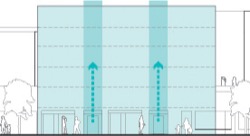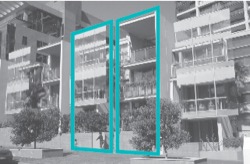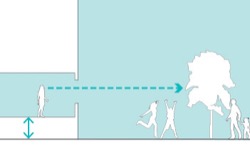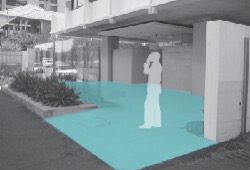On this page:
About higher density residential buildings
Higher density residential buildings house a number of individual apartment dwellings in a single building, and are 5 or more storeys in height.
They may be residential only or residential combined with other uses such as retail, offices or car parking. They are often located in or close to activity centres, and within walking distance of a wide range of services, employment opportunities and public transport. Higher density residential buildings may include common entrance and circulation spaces. Open space for residents may be provided as private balconies, or as communal open space at ground level or on upper level terraces.
Why is it important?
Higher density residential buildings contribute to housing choice and meeting the needs of a growing population. Where located in or near activity centres, they provide residents with easy access to services and facilities. When designed to integrate with their surroundings, they minimise impacts on adjacent lower scale or density residential areas.
Apartment building design needs to take into account the number and diversity of its residents. As people are present 24 hours a day, 7 days a week, this type of housing can improve residents' perceptions of personal safety and enhance the viability of nearby businesses.
5.2.1: create a sense of address for dwellings within higher density residential buildings
- Create multiple building entries that serve smaller groups of dwellings within a building

Tip: by having a smaller number of dwellings sharing a single street entry, each unit or group of units has a greater sense of individual identity and street address. Multiple entries to a residential building also provide more activity and interest to the street. - Arrange building façades to identify individual dwellings.

Tip: façade materials and elements, such as balconies and windows, can reduce the apparent overall building scale, assist individual dwellings to be identified from the street, thus enhancing a sense of ownership for residents. - Where ground floor dwellings face the street, provide individual entrances to each dwelling.
5.2.2: enable informal surveillance of streets and public spaces from higher density residential buildings
- Elevate ground floor dwellings to provide views to adjacent public spaces and streets.

Tip: elevating dwelling floor levels and balcony spaces slightly above the street level provides both a sense of privacy and better sightlines to streets and public spaces. - Locate windows of living areas to overlook streets and other public spaces.
5.2.3: support safe and convenient access and circulation for residents and visitors to higher density residential buildings
- Locate the main pedestrian entry to be clearly visible and accessible from the street.
Tip: building entrances help visitors orient themselves. Entries and foyers should be comfortable, sheltered, safe, convenient and visible at all times of day and night.
- Provide shelter and waiting space on the street at pedestrian entries to buildings.

Tip: higher density residential buildings often have secure entries requiring visitors to buildings to wait on the street. - Provide clear sightlines from the building foyer to the street so people can see both in and out when entering or leaving a building.
- Lay out building entry areas to achieve direct sightlines from the outside of the entry door to all of the lobby space.
- Provide mail boxes and parcel post facilities close to the building entries in an active, well lit and weather protected area, with potential for informal surveillance.
5.2.4: minimise noise reverberation between faces of neighbouring higher density residential buildings
- Apply sound diffusing surfaces to walls within light courts, or walls facing onto streets or lanes less than 7.5 m wide.
- Locate mechanical plant rooms in sound insulated areas.
- Shield adjacent dwellings from mechanical plant noise.
5.2.5: maintain common spaces, services and landscaped areas to ensure residents’ safety in higher density residential buildings
- Locate waste bin storage areas away from property boundaries so the bins cannot be used to climb walls and fences.
- Maintain landscaping near higher density residential building entries to remove potential concealment places.
Page last updated: 09/06/23